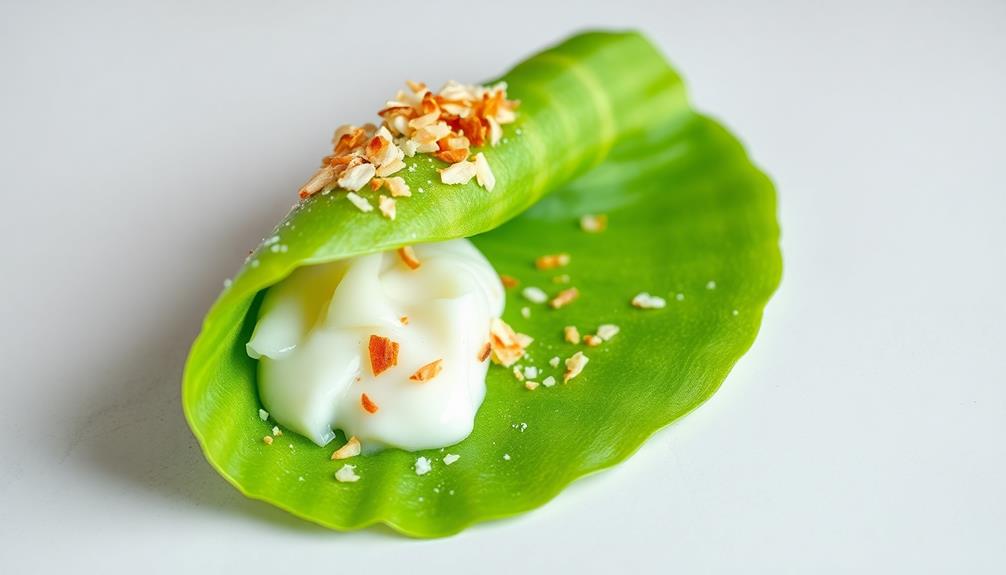You'll love Sate Lilit, a delicious Balinese fish satay that's bursting with flavor! Originating from Indonesia's vibrant food culture, this dish features minced fish, coconut, and an array of aromatic spices wrapped around skewers. The name comes from the Balinese words "sate" (skewered meat) and "lilit" (to wrap), reflecting the unique presentation. Sate Lilit's balance of textures and tastes evokes the lively markets of Bali, making it a beloved snack or main course. Grilled to perfection, it's often served with the zesty Balinese sambal matah – a combination that'll have your taste buds dancing. Keep reading to discover more about this captivating Indonesian treasure. For an authentic Balinese dining experience, pair Sate Lilit with a fragrant Javanese coconut rice recipe, known as Nasi Uduk. The creamy coconut flavor of the rice complements the bold and spicy flavors of the satay, creating a harmonious and satisfying meal. Whether enjoyed at a traditional Balinese warung or prepared at home, Sate Lilit is sure to transport you to the vibrant and diverse culinary landscape of Indonesia.
Key Takeaways
- Sate Lilit is a traditional Indonesian dish from Bali, featuring a unique blend of minced fish, coconut, and spices wrapped around skewers.
- The dish's name is derived from Balinese words "sate" (skewered meat) and "lilit" (to wrap), reflecting its cultural significance.
- Sate Lilit is known for its vibrant flavors, combining the freshness of fish with the crunchy texture of grated coconut and aromatic spices.
- The dish can be enjoyed as a main course or a snack, appealing to both seasoned food enthusiasts and newcomers to Indonesian cuisine.
- Sate Lilit is often served with the traditional Balinese sambal matah, a zesty condiment that complements the dish's flavors.
History
The origins of Sate Lilit can be traced back to the rich culinary traditions of Indonesia. This beloved Balinese dish has been a staple for centuries, passed down through generations of home cooks and street vendors.
Sate Lilit's unique name derives from the Balinese words "sate" meaning skewered meat, and "lilit" meaning to wrap or coil.
Traditionally, Sate Lilit is made by mincing fish, such as tuna or mackerel, and blending it with an array of aromatic spices like lemongrass, kaffir lime, and shallots. The mixture is then wrapped around bamboo or lemongrass skewers, creating a distinctive coil-like shape.
The skewers are then grilled over an open flame, infusing the fish with a smoky, savory flavor.
This delightful dish is often served as an appetizer or snack, enjoyed by locals and travelers alike.
The combination of fresh seafood, fragrant spices, and a unique presentation make Sate Lilit a true culinary delight from the island of Bali.
Recipe
Sate Lilit is a traditional Balinese dish that features minced fish or meat that's seasoned and then wrapped around a lemongrass skewer. The result is a flavorful and aromatic grilled satay that's a beloved part of Balinese cuisine.
This recipe will guide you through the process of creating your own delicious Sate Lilit at home. With its complex blend of spices and herbs, this dish is sure to impress your guests and transport your taste buds to the tropical island of Bali.
Ingredients:
- 1 lb minced fish (such as tuna, mackerel, or barramundi)
- 1/2 cup grated coconut
- 3 lemongrass stalks, finely chopped
- 2 kaffir lime leaves, finely chopped
- 2 Thai chilies, finely chopped
- 3 cloves garlic, minced
- 1 shallot, finely chopped
- 1 tsp ground coriander
- 1 tsp ground cumin
- 1/2 tsp ground turmeric
- Salt and pepper to taste
- Bamboo skewers, soaked in water for 30 minutes
In a large bowl, combine the minced fish, grated coconut, lemongrass, kaffir lime leaves, Thai chilies, garlic, shallot, coriander, cumin, and turmeric. Season with salt and pepper to taste. Mix well until all the ingredients are evenly distributed.
To assemble the Sate Lilit, take a small handful of the fish mixture and mold it around the end of a soaked bamboo skewer, shaping it into a sausage-like cylinder. Repeat with the remaining mixture and skewers.
When ready to cook, preheat your grill or grill pan to medium-high heat. Grill the Sate Lilit for 2-3 minutes per side, or until the fish is cooked through and the exterior is lightly charred. Serve hot, with your choice of dipping sauces or accompaniments.
To ensure the best results, be sure to use very fresh fish and handle it gently to prevent the mixture from becoming tough. Additionally, soaking the bamboo skewers in water before assembling the Sate Lilit will help prevent them from burning during the grilling process.
Cooking Steps
Finely mince the fish to get the perfect texture.
Mix the fish with an array of aromatic spices to create a flavor-packed filling.
Now, it's time to skewer the fish mixture and grill them to perfection – the smoky aroma will have your mouth watering!
Step 1. Finely Mince the Fish

Mincing the fish is the crucial first step in crafting the flavorful sate lilit. You'll want to select a firm, fresh white fish like mackerel or tuna. Using a sharp knife, carefully fillet the fish, discarding any bones.
Now, it's time to mince the meat into a fine, almost paste-like consistency. This can be done by repeatedly chopping and pressing the fish against your cutting board. Did you know that chia seeds, known for their ancient nutritional uses, were also a staple in traditional diets?
Be sure to work quickly, as you don't want the fish to warm up too much. The finer the mince, the better the texture will be in the final dish. Once the fish is properly minced, transfer it to a bowl and set it aside.
This delicate foundation will soon be enhanced with an aromatic blend of spices, coconut, and fragrant herbs – the building blocks of authentic sate lilit. With the fish prepped, you're one step closer to creating this beloved Balinese specialty.
Step 2. Mix Fish With Spices

With the finely minced fish ready, it's time to blend in the aromatic spices that will infuse the sate lilit with its signature flavor.
In a large bowl, combine the minced fish, shallots, garlic, turmeric, coriander, and a pinch of sea salt. Don't be shy with the spices – the more you add, the more vibrant the sate lilit will be.
Use your hands to mix everything together thoroughly until the fish is well-coated and the spices are evenly distributed. The mixture should have a cohesive, slightly sticky texture.
Once you're satisfied with the seasoning, it's time to start shaping the sate lilit. Take a small handful of the fish mixture and mold it around a sturdy lemongrass stalk, forming an elongated oval shape.
Repeat this process until you've used up all the fish mixture. With the sate lilit ready, it's time to move on to the next step: grilling them to perfection.
Step 3. Skewer the Fish Mixture

Once the fish mixture has been thoroughly combined with the aromatic spices, you can begin skewering the sate lilit.
Grab a handful of the seasoned fish and shape it around the end of a thin skewer, forming an elongated oval shape. Make sure to pack the mixture tightly so it holds its form.
Repeat this process, shaping the fish mixture around each skewer until you've used up all the flavorful blend.
As you work, be gentle yet firm, molding the fish securely onto the skewers. The goal is to create a smooth, cohesive shape that will hold together perfectly during the cooking process.
Once all the sate lilit are assembled, you're ready to move on to the next step – grilling or baking these delectable Balinese fish satays to golden-brown perfection.
Get ready for the incredible aroma and mouthwatering flavors that are about to emerge from your kitchen!
Step 4. Grill the Skewered Fish

Preheat your grill or oven to a high temperature, around 400°F (200°C).
Once it's nice and hot, it's time to grill those skewered fish! Carefully place the skewers onto the grill grates, making sure they're not too crowded.
You'll want to give them a few minutes on each side, flipping them gently with tongs to get an even char.
Keep a close eye on them, as the fish can cook quickly at this high heat. You'll know they're ready when the fish has turned opaque and flakes easily with a fork.
Don't be afraid to test a piece to ensure it's cooked through.
Once they're grilled to perfection, carefully remove the skewers from the grill.
Serve the sate lilit hot, garnished with the traditional accompaniments like shredded coconut, sambal, and lime wedges.
The smoky, savory flavors are sure to delight your taste buds. Enjoy this authentic Balinese dish!
Step 5. Serve With Balinese Sambal Matah

To complement the grilled sate lilit, you'll want to prepare a zesty Balinese sambal matah. This vibrant condiment is the perfect match for the fragrant, tender fish skewers.
Start by thinly slicing some lemongrass, shallots, and kaffir lime leaves. Combine them in a bowl. Next, mince some fresh chilies and add them to the mix. Drizzle in some coconut oil and a splash of lime juice. Sprinkle in a bit of shrimp paste and a pinch of salt. Give everything a good stir, making sure the flavors meld together.
The result is a bright, tangy, and spicy sambal that adds a lovely contrast to the richness of the sate lilit. Spoon the sambal matah over the grilled fish skewers and enjoy the burst of flavors in every bite.
The fresh, crunchy textures complement the tender, flavorful sate lilit perfectly. Get ready for your taste buds to be delighted!
Final Thoughts
Ultimately, sate lilit is a delightful and versatile Indonesian dish that you can't help but savor. The unique blend of spices, the tender fish, and the satisfying texture create a truly memorable culinary experience.
As you take your first bite, you'll be transported to the vibrant markets of Bali, where the aroma of this beloved dish fills the air.
One of the best things about sate lilit is its adaptability. You can enjoy it as a main course, a snack, or even as part of a larger spread of Balinese specialties. The accompanying Balinese sambal matah adds an extra layer of flavor, perfectly complementing the richness of the sate lilit.
Sate lilit is a delightful way to explore the rich culinary traditions of Indonesia. Whether you're a seasoned food enthusiast or a curious newcomer, this dish is sure to leave a lasting impression on your taste buds and your heart.
Frequently Asked Questions
What Is the Traditional Serving Style for Sate Lilit?
The traditional serving style for this dish usually involves arranging the grilled skewers on a platter, often garnished with fresh herbs, shredded coconut, or chili peppers. You'd typically serve it with steamed rice and various condiments for dipping.
How Long Can Leftover Sate Lilit Be Stored?
Leftover sate lilit can be stored in the refrigerator for up to 3-4 days. Make sure to store it in an airtight container and reheat it thoroughly before serving. Enjoy your leftovers within this timeframe for the best quality and safety.
Can Sate Lilit Be Made With Different Types of Fish?
You can use different types of fish to make sate lilit. Traditionally, it's made with mackerel or tuna, but you can experiment with other firm, oily fish like salmon or halibut for unique flavor variations.
What Are Some Common Accompaniments for Sate Lilit?
Some common accompaniments for sate lilit include steamed rice, sambal matah (a Balinese raw chili relish), and various vegetable dishes. You can also serve it with a simple cucumber and tomato salad to balance the rich flavors.
Is Sate Lilit a Healthy Option for a Meal or Snack?
Sate lilit can be a healthy option, depending on the preparation. The fish provides lean protein, while the coconut and spices offer beneficial nutrients. However, it's important to consider portion sizes and any additional accompaniments to maintain a balanced and nutritious meal.










